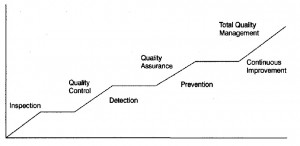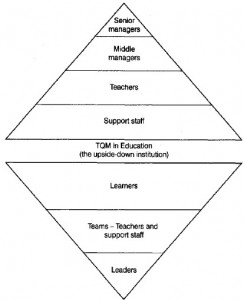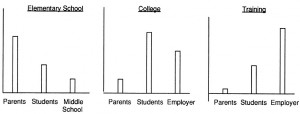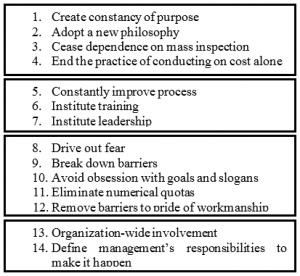Total Quality Management in Education
Dream Team (a learning circle in International teacher education 2013-12014 in Teacher Education College in Jyväskylä) is an international group of students studying to achieve the qualification of a vocational teacher.
Dongbin Yang
International Group 13 – 14
Teacher Education College
JAMK University of Applied Sciences
Total quality management (TQM) is introduced into our study. TQM is a systematic program that indicates everyone and everything in the organization is involved in the enterprise of continuous improvement. Frazier (1997) stated quality management provides a connection between outcomes and the process by which outcomes are achieved. If the cause of failures in education is a problem in design, quality management may be regarded as an ideal systemic process for managing change in public education. TQM is used to describe two slightly different but related notions. The first is a philosophy of continuous improvement. The second related meaning uses TQM to describe the tools and techniques. TQM is both a mind-set and a set of practical activities- an attitude of mind as well as a method of promoting continuous improvement.

As an approach, TQM represents a permanent shift in an institution’s focus away from short-term expediency to the long-term quality improvement. Herman and Herman (1994) stated three levels of application of quality management in education. The first level is to the management process of a school, including strategic planning, recruiting and staff development, deploying resources, and alignment of what is taught, how it is taught, and how it is assessed. The next level is teaching quality to students. Students are recognized as both customer and workers in the educational system. Administrators need to involve students in their own education by training them to evaluate the learning process and accept responsibility for their learning. Robert and Robert (1998) addressed the most influential factor in success or failure of a TQM implementation effort is universal endorsement. If management is not completely sold on TQM, it is unlikely that an implementation effort will be successful. Endorsing TQM represents a fundamental change in the way. Less than full support by anyone in the chain of authority essentially condemns the effort to failure.
TQM is usually accomplished by a series of small-scales incremental projects. The philosophy of TQM is large-scale, inspirational and all-embracing, but its practical implementation is small-scale, highly practical and incremental. Solid and lasting change is based on a long series of small and achievable projects (Edward 3rd, 2002). TQM requires the change entirely for organization. Change of culture is notoriously difficult to bring about and takes into implement. It requires a change of attitudes and working methods. Two things are required for staff to produce quality. First, staff needs a suitable environment in which to work. The tools of trade, system and procedures should aid them in doing their jobs. The environment that surrounds staff has a profound effect on their ability to do their job properly and effectively. Second, encouragement and recognition of success and achievement should be deserved from leaders who can appreciate their achievement and coach them to greater success (Edward 3rd, 2002).

The customers’ focus is the priority in the set of relationship in education. The upside-down organizational focus does not affect the structure of authority in the school and college, and neither does it diminish the essential leadership role of senior managers. The inverted hierarchy emphasizes service-giving relationship and the important of the customer to the institution (Edward 3rd, 2002).
To meet the needs and wants of its customers is primary mission in TQM. Quality must be matched to the expectation and requirement of customers and clients. Quality is what the customer wants and not what the institution decides is best for them. Education faces a considerable challenge in its relationships with its external customers. Expectations are diverse and often contradictory and quality of program is often confused in the public mind with the reputation of the institution (Edward 3rd, 2002). TQM will be the result of the relative weight assigned to each of the customers at the different levels of education.
Robert and Robert (1998) indicated that in the elementary schools the most important customers are the parents of the students, the students themselves and the middle school to which the students are headed. As maturity of the students increases, the students replace the parents as the most important customer. In a training situation, the most important customer is the organization that needs the individuals trained. In addition, Edward (2002) indicated customers also include internal customers such as everyone working in a school, college or university is both a supplier of service and a customer of others. It is important to ensure internal customer function efficiently and effectively by identifying to whom people provide services.

Education is about learning. An educational institution that takes the total quality route must take seriously the issue of learning styles and needs to have strategies for individualization and differentiation in learning. Educational institutions have an obligation to make learners aware of the variety of learning methods available to them. They need to give learners opportunities to sample learning in a variety of different styles. Institutions need to understand that many learners also like to switch and mix “n” –match styles and must try to be sufficiently flexible to provide choice in learning. Learner is the primary customer and it will not possible to claim achievement of total quality without meeting individual needs (Edward 3rd, 2002). It will be fundamental to utilize principles of TQM in education and to start with “all shared succeed” to establish mission between learners and their teachers. The framework for implementation of TQM was presented by Dr. W. Edwards Deming. TQM principles could be used as a checklist for implementation (Robert and Robert, 1998):
 The establishing of a strong evaluation process is also an important element of any quality assurance process. Evaluation should be a continuous through entire TQM process and not just left until the end of the program of study. Learners will be involved in evaluation process and evaluate themselves during learning process and results of evaluation should be discussed by means of completing a record of achievement (Dylan, Clare, Christine & Paul, 2004). The principles of TQM can also be applied to high school, middle school, and elementary school educational process as well as training situation. These can be powerful tool in educational setting and key elements to a successful implementation are 1) gain the support of everyone in the chain of supervision, 2) identify customers, 3) focus on refining the process and 4) use Deming’s 14 points as a guide and checklist during the implementation effort (Robert and Robert, 1998).
The establishing of a strong evaluation process is also an important element of any quality assurance process. Evaluation should be a continuous through entire TQM process and not just left until the end of the program of study. Learners will be involved in evaluation process and evaluate themselves during learning process and results of evaluation should be discussed by means of completing a record of achievement (Dylan, Clare, Christine & Paul, 2004). The principles of TQM can also be applied to high school, middle school, and elementary school educational process as well as training situation. These can be powerful tool in educational setting and key elements to a successful implementation are 1) gain the support of everyone in the chain of supervision, 2) identify customers, 3) focus on refining the process and 4) use Deming’s 14 points as a guide and checklist during the implementation effort (Robert and Robert, 1998).
Dongbin Yang
Language teacher
Temporary lecturer, Vaasa University
References
Frazier, A. 1997. A roadmap for quality transformation in education. Boca Raton, Fla.:St. Lucie Press
Herman, J., and j. L. Herman. 1994. Education quality management: Effective schools through systematic change. Lancaster, Pa.: Technomic Publication Co.
Edward, Sallis 2002, Total Quality Management in Education, 3rd edition, ISBN 0-203-44325-X (Adobe eReader Format)
Robert C. Winn and Robert S. Green 1998. Applying Total Quality Management to the Educational Process. Int. J. Engng Ed. Vol. 14, No. 1, p.24-29.
Dylan William, Clare Lee, Christine Harrison & Paul Black, 2004 Teacher Developing Assessment for Learning: Impact on student achievement, Assessment in Education, Vol.11 No.1